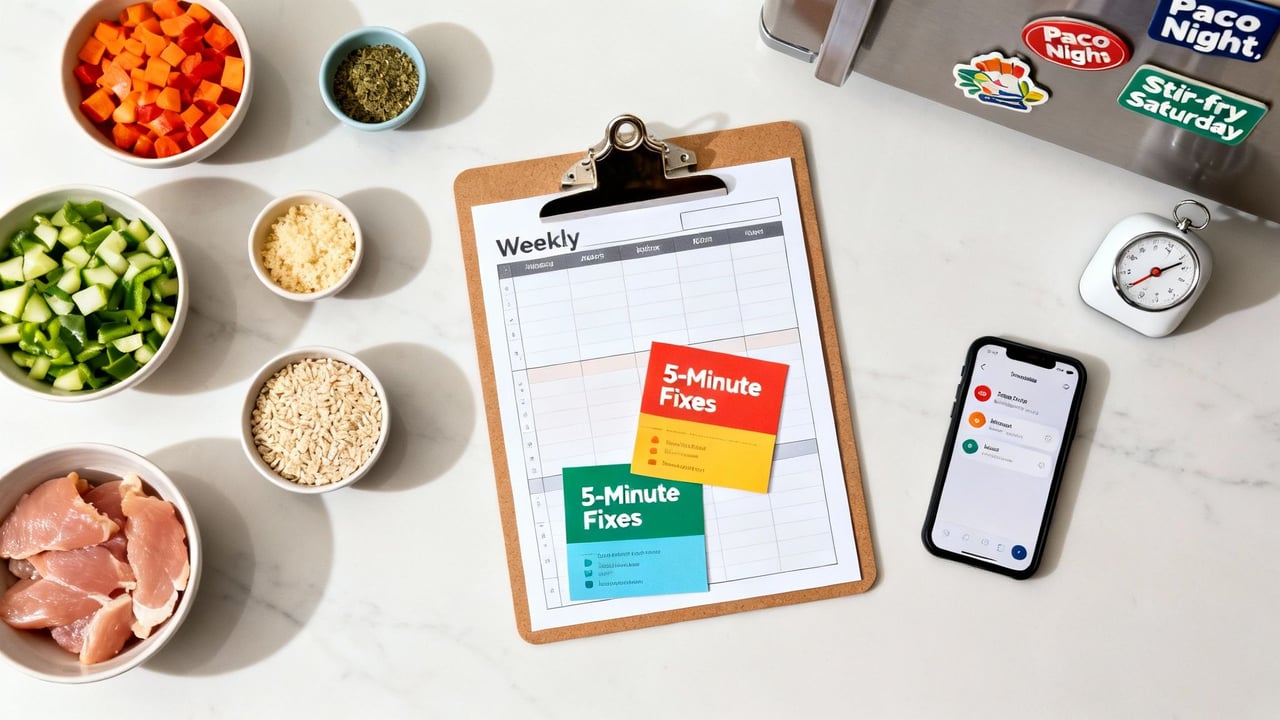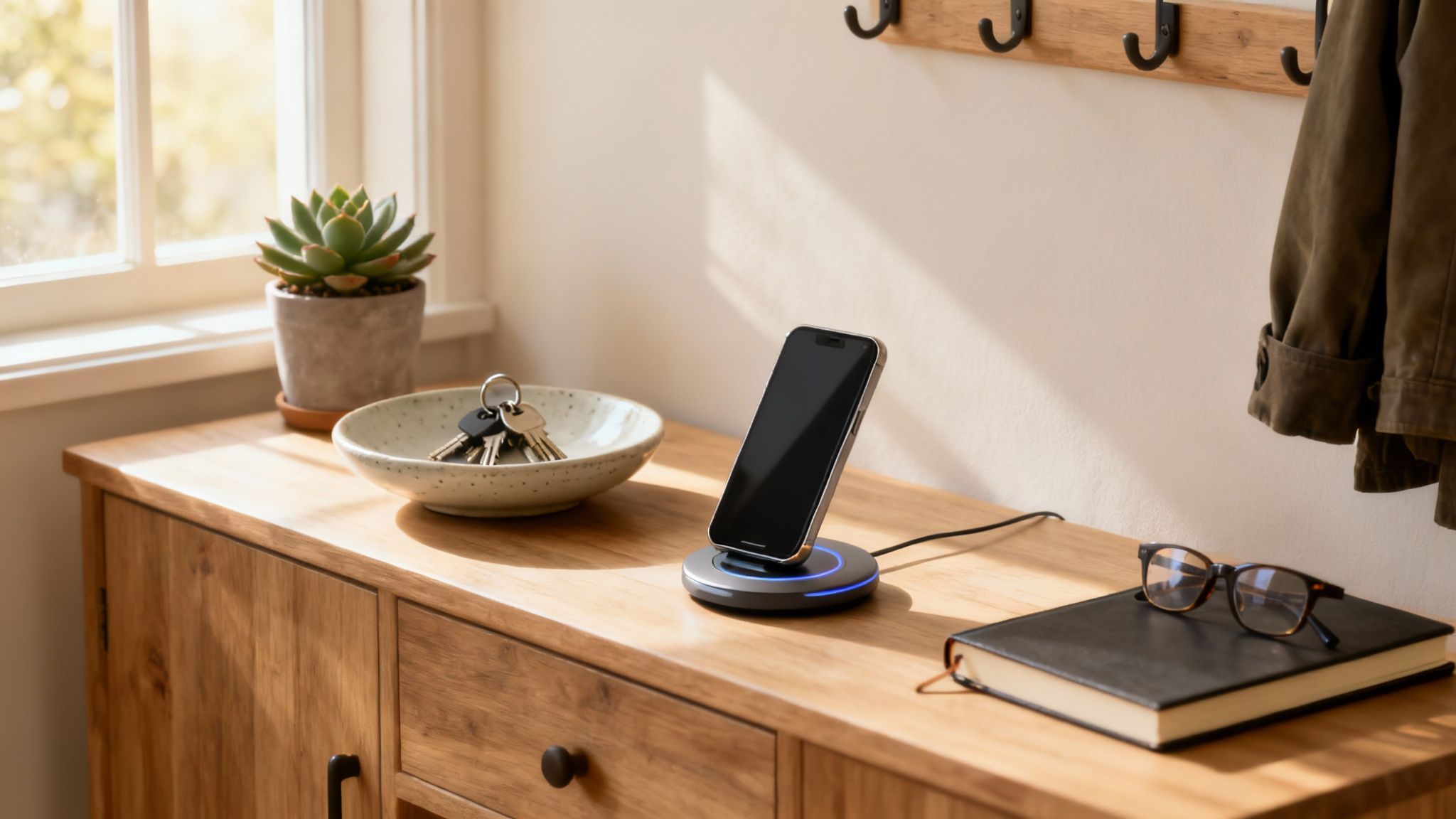Does the thought of planning meals for the week make you want to just order takeout instead? If you've ever stood in front of an open fridge, completely overwhelmed by the choices, you’re not alone. This isn't a personal failure; it's a common experience for people with ADHD. Standard meal-planning advice often doesn't work for brains wired for novelty and flexibility.
An ADHD-friendly system doesn’t fight against traits like decision fatigue, time blindness, and impulsivity. It works with them. This guide will help you build a simple, low-stress routine that feels less like a chore and more like an act of self-care.
Why Meal Planning Feels So Hard with ADHD
That feeling of dread that washes over you when you think about planning a week of meals? It’s real and it’s valid. The entire process—from deciding what to eat, to buying the groceries, to actually cooking—is a marathon of executive functions. For many people with ADHD, these are the very skills that can feel the most challenging.
This is exactly why that super-organized, color-coded meal plan your neurotypical friend swears by might feel completely impossible for you. Generic advice often assumes a straight line from A to B, but for many of us, the path is more of a scenic route. Let’s explore the specific neurological hurdles that can turn "what's for dinner?" into a major source of stress.
The Executive Function Overload
At its heart, meal planning is a massive drain on your executive functioning skills. Think of these as your brain's project manager—the part that helps you organize, plan, and execute tasks. For those of us navigating the challenges of executive dysfunction, meal planning hits all the sensitive spots:
- Decision Fatigue: Just choosing one dinner can be tough. Choosing seven? That’s dozens of tiny decisions that pile up, leading to burnout before you've even written a grocery list. You might recognize this as the feeling of being so overwhelmed by choice that you can't choose anything at all.
- Working Memory: Trying to hold onto what ingredients you already have, what you need to buy, and the steps of a recipe all at once is a huge mental load. It's common for an important ingredient or step to get forgotten along the way.
- Time Blindness: "Oh, that'll only take 30 minutes." Does this sound familiar? People with ADHD often find it difficult to accurately estimate how long tasks like shopping, prepping, and cooking will actually take. This is why dinner sometimes gets started way too late, or ambitious plans get scrapped for something quicker.
- Task Initiation: The sheer number of steps involved can trigger "analysis paralysis"—that feeling of being so overwhelmed you can't figure out where to begin.
🔬 Scientific Takeaway: The cycle is often predictable: you feel swamped by the planning, impulsively grab whatever is easiest (and often less healthy or more expensive), and then feelings of guilt can set in. This can reinforce the unhelpful belief that you "can't" do it. Breaking this pattern starts with understanding it.
Impulsivity and Irregular Eating Patterns
When you struggle with maintaining attention, the multi-step process of meal planning can feel insurmountable. This is where learning a few strategies to improve focus and concentration can make a real difference.
But impulsivity can also affect your eating schedule. Maybe you skip meals because you're hyperfocused on a project, only to become intensely hungry later and reach for the nearest high-sugar snack for a quick dopamine hit. Many people with ADHD recognize this pattern.
This isn't just a quirky habit; it can have significant impacts. Some research suggests a link between ADHD and a higher likelihood of developing disordered eating patterns, such as binge eating. The combination of executive dysfunction and impulsivity can create a perfect storm for struggling with a consistent, nourishing diet.
Simply recognizing these patterns in your own life is the first, most powerful step. In the next sections, we'll dive into ADHD-friendly strategies to build a routine that feels supportive, not punishing. Have you noticed this pattern in your own life?
Building Your Low-Demand Meal System
Let’s be honest: rigid schedules and elaborate recipes can be a one-way ticket to overwhelm for the ADHD brain. The secret isn't more discipline; it's a different approach. The goal is to build a flexible, low-demand system that works with your brain's need for simplicity, not against it.
We want to create a Minimum Viable Plan—just enough structure to prevent the "what's for dinner?" panic without triggering decision fatigue. It’s about making peace with your kitchen, one manageable step at a time.
For many of us with ADHD, the mere thought of planning can feel like hitting a wall, and the whole process short-circuits before it even begins. This infographic sums it up perfectly.
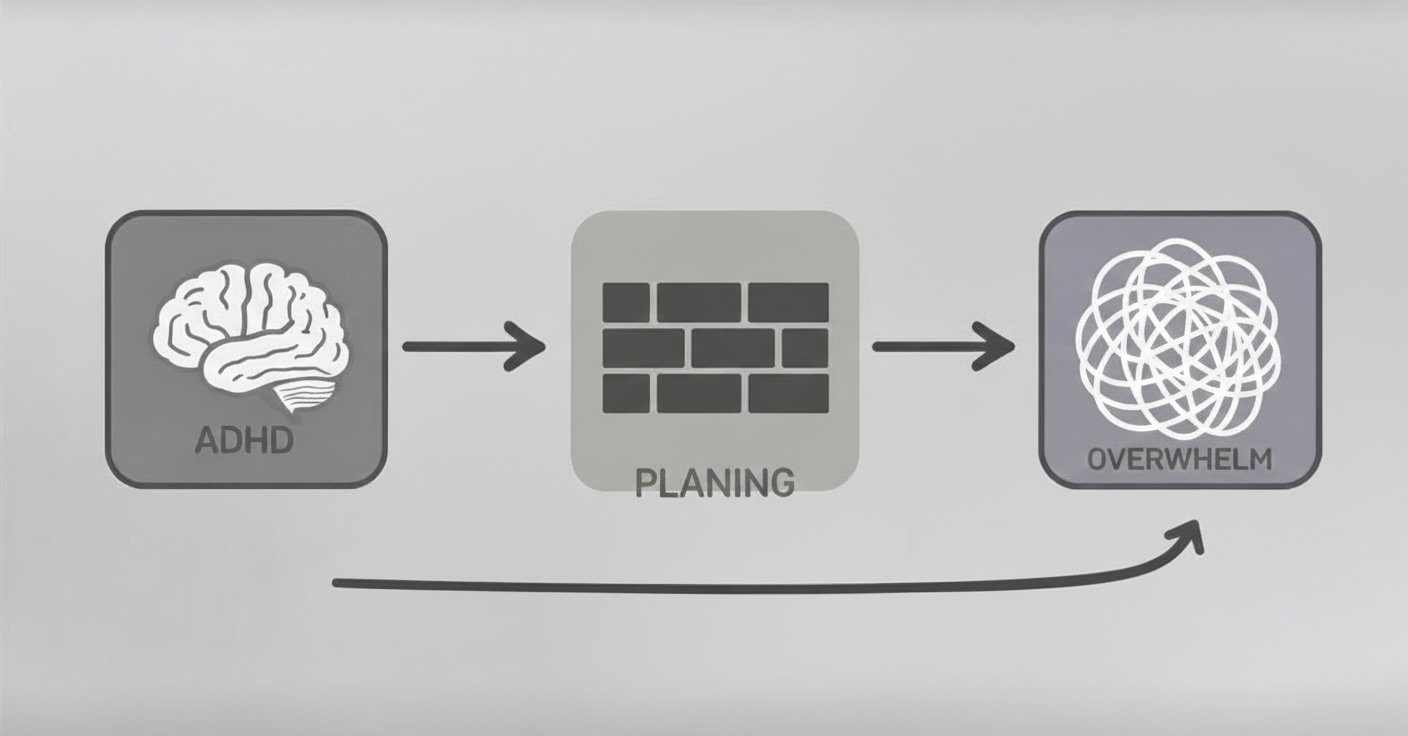
It captures how executive function challenges can turn a simple intention—"I should plan my meals"—into a spiral of overwhelm that ends with, well, no meal at all.
Create a 'Master List' of Go-To Meals
First things first: let's create your own personal menu. Grab a piece of paper or open a note on your phone and brainstorm every meal you actually enjoy and know how to make. Don't judge it, just list it. Cereal for dinner? Write it down.
Once you have your list, sort it by effort level. This is a game-changer because it allows you to match your cooking plan to your actual energy levels on any given day.
- 💡 5-Minute Fixes: These are your emergency meals when you just can't. Think yogurt bowls, scrambled eggs, pre-made soup, or a rotisserie chicken with a bagged salad. No real cooking required.
- 💡 30-Minute Favorites: These are the reliable, fairly easy meals you can pull off on a typical weeknight. This might be your go-to spaghetti bolognese, sheet-pan sausages with veggies, or simple tacos.
- 💡 Low-Spoons Day Savers: This is for the days when your executive function battery is at 0%. Frozen pizza, instant noodles, or that bowl of cereal are all valid choices. Having a planned "low-spoons" meal stops the guilt and the last-minute takeout spending.
🔬 Scientific Takeaway: This master list becomes your trusted resource. It eliminates the dreaded "what should I make?" question because you've already made those decisions when you were in a calm state of mind. It's a safety net of reliable options you've already pre-approved.
Use Themed Nights Instead of Specific Recipes
Now, let's build a weekly template that reduces decision fatigue. Instead of trying to plan a specific, brand-new recipe for every single night (which can be a recipe for disaster), just assign a simple theme to each day. This gives you structure without being suffocatingly rigid.
This is a fantastic way to bring the principles of building sustainable ADHD-friendly routines right into your kitchen. Your weekly template could look something like this:
- ✅ Monday: Pasta Night
- ✅ Tuesday: Taco/Burrito Night
- ✅ Wednesday: Leftovers / 5-Minute Fix
- ✅ Thursday: Soup & Sandwich Night
- ✅ Friday: Pizza Night (frozen or homemade)
- ✅ Saturday: Stir-fry Saturday
- ✅ Sunday: 'Clear the Fridge' Night
With a system like this, the only decision you have to make is which pasta dish or what kind of tacos to make, pulling from your Master List. For more on this, there are some great strategies for learning how to plan weekly meals you’ll actually use.
This approach provides the repetition your brain can find comfort in, while still leaving room for novelty when you have the energy for it.
Taming the Grocery Store Beast
Okay, you've got your flexible meal themes. Awesome. Now comes the next challenge: the grocery store. For an ADHD brain, this place can be a sensory nightmare. The fluorescent lights, the endless choices, and the crowded aisles can spike anxiety, leading to decision fatigue and a cart full of impulse buys.
But you can get through it. With a little strategy, you can make the trip less overwhelming. The goal is to reduce aimless wandering and take as much thinking as possible off your plate once you're inside. This starts before you even leave the house.
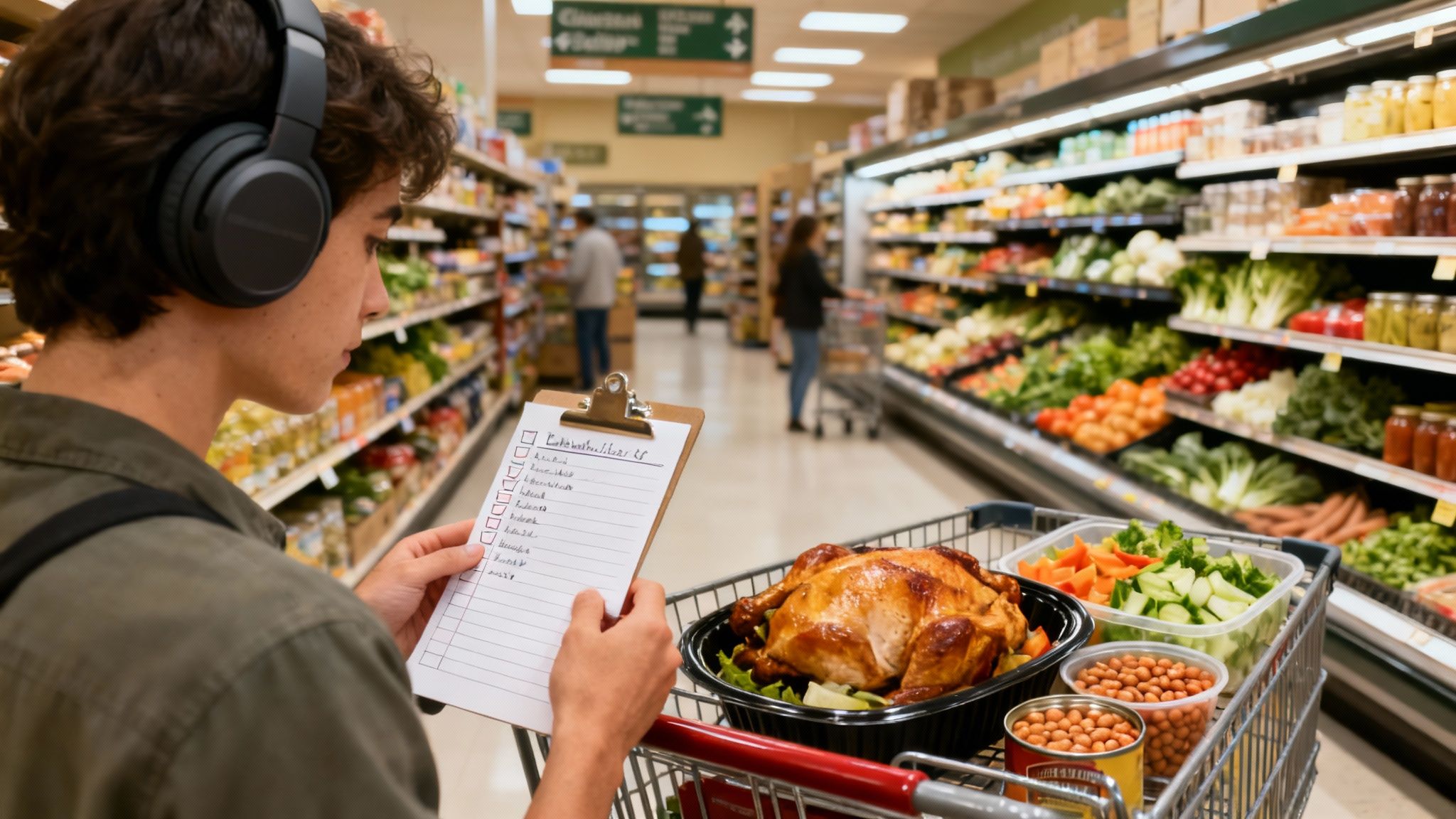
Your Shopping List is Your Map
Your list is your most powerful tool against grocery store chaos. Instead of just scribbling down items as they pop into your head, try organizing the list based on the store's layout. This simple trick stops you from pinballing between aisles, which drains your energy and makes you more susceptible to impulse buys.
Try grouping items into categories that match the path you take through the store:
- ✅ Produce: (Onions, bagged salad, apples)
- ✅ Protein: (Chicken thighs, tofu, eggs)
- ✅ Dairy: (Yogurt, milk, cheese)
- ✅ Pantry/Canned Goods: (Pasta, canned beans, rice)
- ✅ Frozen: (Frozen veggies, pizza, chicken tenders)
Suddenly, your random list becomes a step-by-step guide. It tells you exactly where to go next, so you spend less time feeling lost and more time feeling in control.
Defend Against Sensory Overload
The grocery store environment is just a lot. To protect your precious executive function battery, you can actively manage the sensory input.
- 💡 Eat Before You Go: Never shop hungry. A protein-rich snack before you leave can help stabilize your blood sugar and mood, making you less likely to be tempted by the snack aisle.
- 💡 Bring Your Headphones: Noise-canceling headphones can be a game-changer. Pop on a podcast, an audiobook, or some music you love. It creates a personal bubble, blocking out the jarring store announcements and general chatter.
For many of us with ADHD, the constant stimulation of a busy store is what makes the whole thing so exhausting. When you intentionally dial down the sensory noise, you save your mental energy for the real mission: getting your food and getting out.
Embrace the Convenience Aisle
Let's be real for a second. You are not going to cook every single meal from scratch, and that is 100% okay. Leaning into convenience isn't a failure; it's a brilliant strategy. Stocking your kitchen with low-effort staples is how you survive the days when your energy is at zero.
Think of these as your "in case of emergency, break glass" foods:
- ✅ Pre-chopped vegetables (fresh or frozen) because chopping can feel like a huge barrier on some days.
- ✅ Rotisserie chickens for instant protein you can throw into salads, tacos, or pasta.
- ✅ Canned beans and lentils to quickly add fiber and substance to almost anything.
- ✅ Bagged salad kits that are basically a complete side dish with zero prep work.
And if the store itself is the biggest hurdle? Use grocery delivery or curbside pickup. This might be one of the kindest things you can do for your ADHD brain. It lets you bypass the overwhelm completely. By building these supports into your routine, you can make sure you come home with what you need for a successful week of meal planning adhd style.
Rethinking Meal Prep for the ADHD Brain
The idea of a full Sunday spent cooking and portioning meals into a fleet of matching containers can feel completely overwhelming. If that picture-perfect system has never worked for you, please hear this: it's not a personal failure. It’s time to redefine what "meal prep" means for the ADHD brain.
Successful prep isn't about having five identical lunches ready to go. It’s about chipping away at the process with tiny, manageable wins that make cooking later on feel infinitely less daunting.
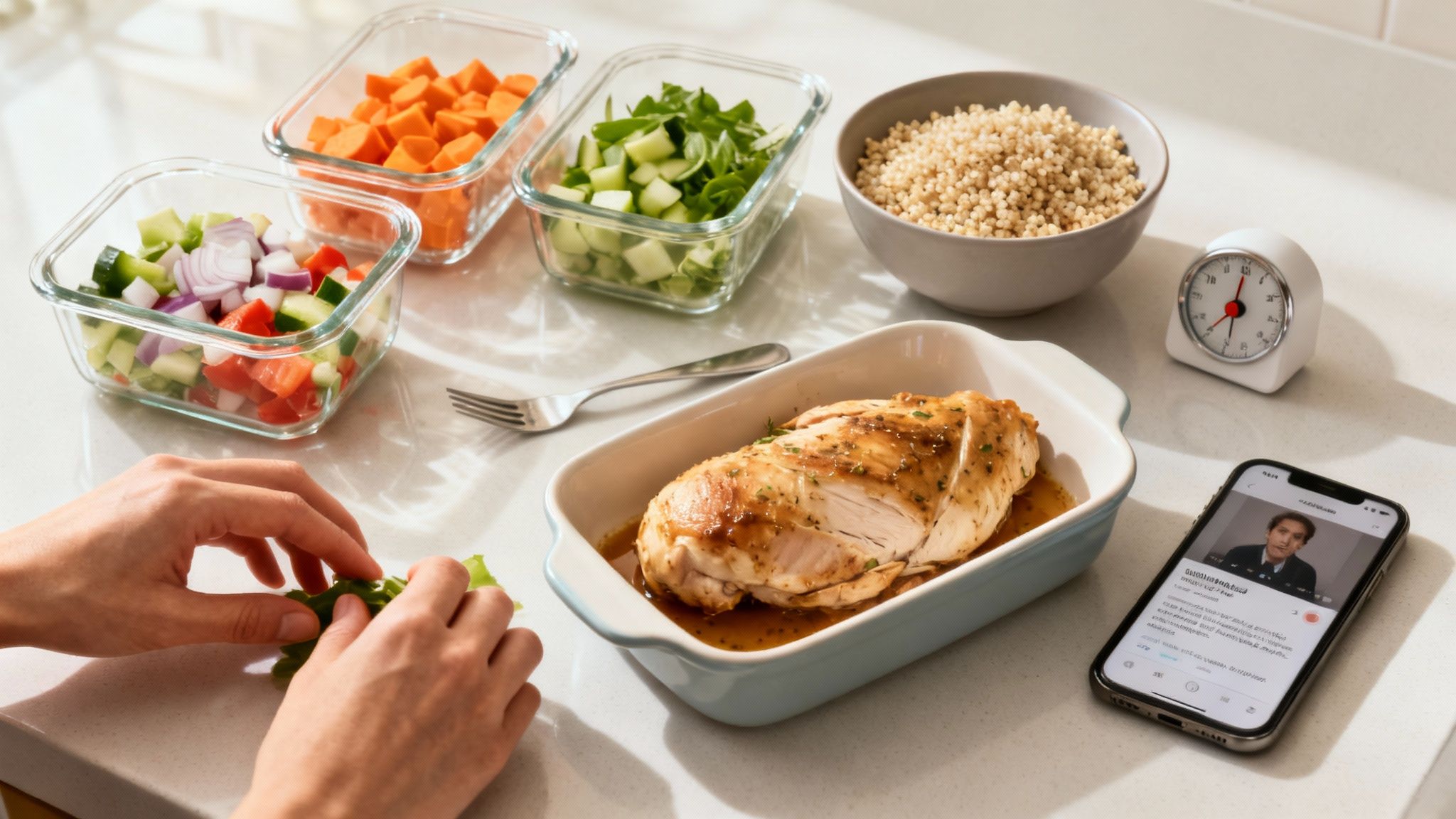
From Meal Prep to Ingredient Prep
The real game-changer is switching your mindset from meal prep to ingredient prep. This is all about doing small, low-effort tasks ahead of time, which drastically lowers the activation energy you need when it's actually time to cook.
Think of it as giving your future, tired self a massive head start. By tackling the most annoying parts of cooking whenever you have a random burst of energy, you're knocking down the biggest barriers to making a meal later.
What does that actually look like?
- ✅ Wash and chop your veggies: Got a podcast you want to listen to? Use that time to wash and chop the onions, peppers, or carrots for the next few days. Just pop them in an airtight container in the fridge.
- ✅ Batch cook a grain: Making a big pot of rice or quinoa takes very little active effort. Let it simmer while you do something else, and suddenly you have a versatile base for meals all week.
- ✅ Marinate a protein: It takes less than five minutes to toss chicken or tofu in a freezer bag with a marinade. That tiny step makes a huge difference in both flavor and how ready-to-cook it feels later.
🔬 Scientific Takeaway: This approach breaks the cooking process into smaller pieces instead of trying to conquer it all at once. Every little task you check off is one less thing you have to do on a Tuesday night when your executive function battery is low.
Find Your Prep Style with Task Batching
Task batching is a classic ADHD-friendly strategy where you group similar tasks together to save mental energy. You can apply this to the kitchen. Instead of feeling like you have to do all the prep, just pick one style that matches your energy level for the week.
- 💡 The "One Big Thing" Method: Just choose one single component to prep a bunch of. Maybe this week, all you do is hard-boil a dozen eggs for quick breakfasts and snacks. That’s it. That’s the win.
- 💡 The "While You Wait" Method: Use those little pockets of downtime that already exist in your day. While the kettle is boiling, wash a few handfuls of spinach. Waiting for your coffee to brew? Rinse a can of beans.
- 💡 The "Body Double" Method: Turn your prep time into a social activity. Put on music and have a friend or partner just be in the kitchen with you while you chop. Just having another person there can make any task feel less like a chore. If you want to go deeper on why this works so well, check out the concept of ADHD body doubling.
When you pair these small prep tasks with something you actually enjoy, you're using a CBT-based technique that can change the game.
Choosing Foods That Support Your Brain
What you eat can have a direct effect on your brain's performance, influencing everything from focus and mood to energy levels. For the ADHD brain, which often navigates a dopamine deficit, nutrition isn't just about physical health—it's about mental clarity.
Let's break down the science in a simple, approachable way. The goal is to help you make choices that feel good and support your brain, without adding a new layer of stress.
This isn't about creating restrictive rules or a list of "bad" foods. Instead, think of it as gently adding more of the things that help your brain thrive.
Power Up with Protein
If there's one nutritional MVP for the ADHD brain, it's protein.
🔬 Scientific Takeaway: Your brain uses the amino acids found in protein to create neurotransmitters. One of the most important ones is dopamine—the chemical messenger crucial for focus, motivation, and reward. When dopamine levels are more stable, managing ADHD symptoms often feels easier.
Starting your day with a protein-rich breakfast can be a game-changer for sharpening your focus. It helps you sidestep that mid-morning brain fog that can follow a sugary, carb-heavy meal.
- 💡 Easy Protein Swaps:
- Instead of just toast with jam, try it with two scrambled eggs or a generous layer of peanut butter.
- Swap out a sugary morning cereal for Greek yogurt with berries and a sprinkle of nuts.
- Add a scoop of protein powder to your morning smoothie for an effortless boost.
This doesn’t mean you have to give up carbs; it just means giving protein a starring role, especially at the start of your day.
Steady Energy from Smart Carbs and Healthy Fats
Have you ever been hit by a sudden energy crash in the afternoon that leaves you feeling irritable and unable to focus? That’s often the result of a blood sugar rollercoaster, kicked off by simple carbohydrates like sugary snacks or white bread. Your brain needs glucose for energy, but it prefers a slow, steady supply.
This is where complex carbohydrates come in. Foods like oatmeal, quinoa, brown rice, and sweet potatoes release their energy gradually, preventing those sharp spikes and crashes.
When you pair them with protein and healthy fats (think avocado, nuts, and olive oil), you slow down digestion even further, providing sustained fuel for your brain. This combination is key to maintaining stable energy and mood throughout the day.
🔬 Scientific Takeaway: Research highlights how significant these nutritional patterns can be. One study found that children with ADHD often consumed more simple sugars and less protein and key minerals compared to their peers. While more research is needed, it points to a potential nutritional gap. You can explore the findings about ADHD and dietary patterns here.
By focusing on balanced meals, you’re not just feeding your body; you’re giving your brain the stable, long-lasting energy it needs to stay on track. Small adjustments, like adding a handful of almonds to your afternoon snack, can make a noticeable difference.
If you’re curious about how specific foods can affect your symptoms, you might find our deeper dive into an ADHD diet and nutrition helpful. Building a supportive food environment is another powerful tool in your ADHD management toolkit.
Common Questions & Troubleshooting
Even the best-laid plans hit a snag. That’s not just okay; it's expected. Think of these hurdles less as failures and more as opportunities to fine-tune your system. Here are some of the most common challenges that pop up when meal planning with an ADHD brain.
"What if I get bored eating the same things?"
Ah, boredom—the archenemy of the novelty-seeking ADHD brain. The secret weapon here isn't a rigid plan but structured flexibility.
Your themed nights give you a reliable foundation, but the details are meant to be changed. "Taco Tuesday" doesn't have to be the exact same ground beef tacos every week. One week it can be chicken fajitas, the next it's burrito bowls. You get the novelty hit without the massive mental energy of starting from scratch.
- 💡 Tip: Schedule a "Try Something New Night" once a month. This carves out dedicated time to experiment with a new recipe or cuisine, satisfying that craving for the new without blowing up your entire week. Remember, your plan is a safety net, not a cage.
"I buy all the ingredients but have zero energy to cook."
This is the classic ADHD gap between intention and action. It’s so common to have the best intentions on Sunday, only to hit a wall of exhaustion by Wednesday. Your meal plan has to be brutally realistic about your energy levels, especially on your worst days.
This is non-negotiable: Always include several "zero-cook" or "five-minute" meals for the week.
- 💡 Rotisserie chicken and a bagged salad kit. Done.
- 💡 A high-quality frozen pizza or some pre-made soup you actually like.
- 💡 Scrambled eggs on toast. Seriously, it counts.
It is always better to have a planned, ridiculously easy meal on hand than to default to expensive, less-nourishing takeout. Learning to recognize your energy dips is a skill, and it's something that cognitive behavioral therapy (CBT) can help with. The Inflow app is designed specifically to help you build that kind of self-awareness.
"How do I handle my sensory issues with food?"
Sensory sensitivities are completely real and can make eating stressful. This is where your "Master List" of go-to meals becomes your absolute best friend. This list should be built almost entirely around foods you know are texturally "safe" and genuinely enjoyable for you.
Lean hard on this list for about 80% of your meals. When you're feeling a bit more adventurous, don't try a whole new meal. Instead, try adding just one new ingredient to a dish you already know and love. This lowers the risk of sensory overload and makes experimenting feel less intimidating.
"How can I get my family on board with this?"
Trying to implement a new system can feel like an uphill battle if you're the only one paddling. The key to getting buy-in is to explain the "why." Frame it as a way to make life less stressful and chaotic for everyone, not just a list of rigid rules. Explain that this system helps your ADHD brain work better, which can mean a calmer home for the whole family.
- 💡 Tip: Build the "Master List" of meals together so everyone's favorites make the cut. Then, give people simple, specific jobs. For example, maybe one kid is always in charge of washing the salad greens, or your partner is always on deck for setting the table on "Pasta Night." Shared ownership transforms it from your chore into a team effort.


